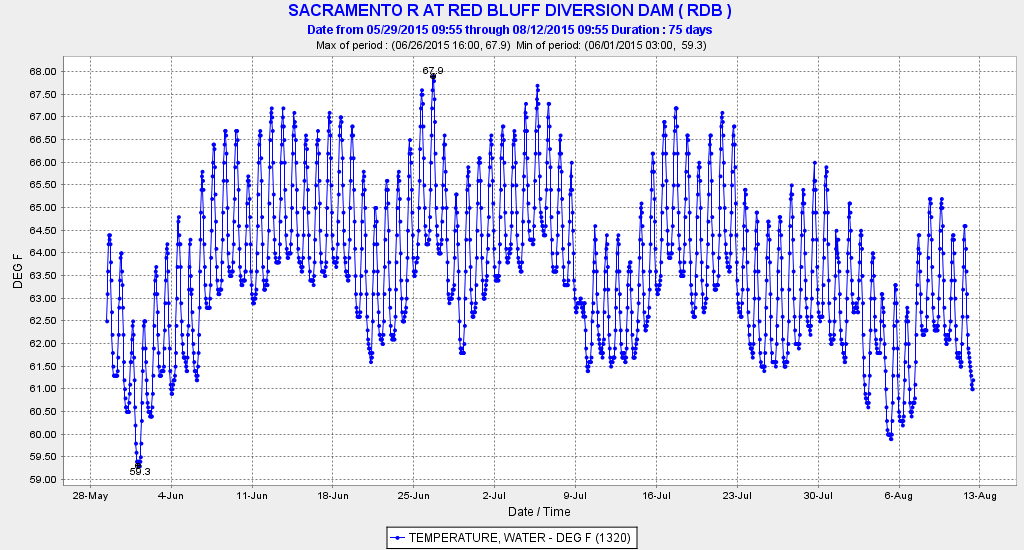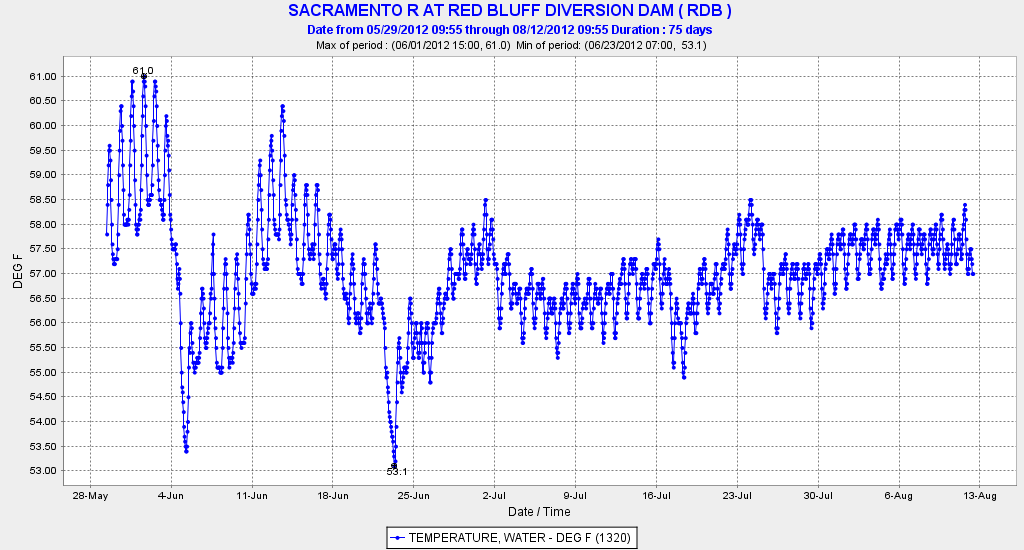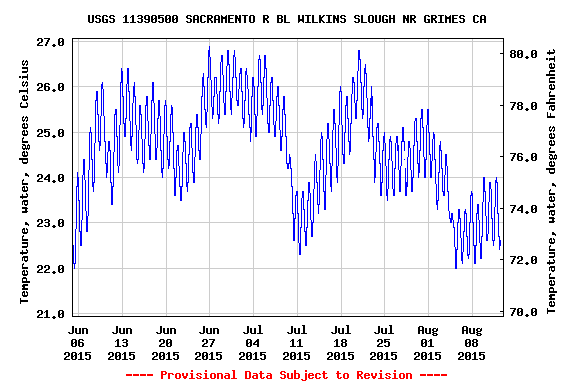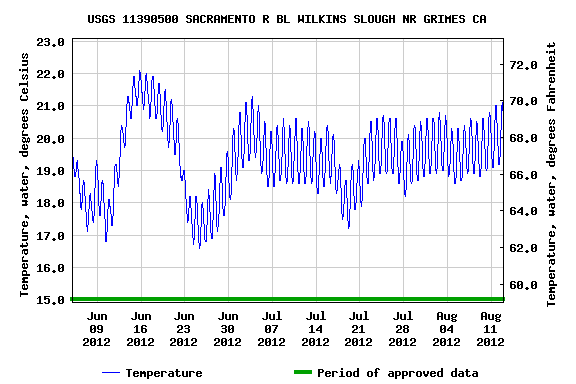The State Water Board’s weakening of the water temperature standards in the Sacramento River below Shasta at the request of Reclamation and concurrence by NMFS this late spring and early summer has likely led to excessive take during this spawning season of listed Green Sturgeon, increasing their risk of their extinction. Lower flows and higher temperatures in the Sacramento River’s Green Sturgeon spawning reach from Anderson (RM 280) to Hamilton City (RM 200) has likely resulted in a substantial mortality of eggs and larval Green Sturgeon, as well as White Sturgeon, during and following their May-June spawning season.
Water temperatures below Red Bluff (RM 240) exceeded the upper thermal optimum for Green Sturgeon embryos (17-18°C, 62-65°F1) from late spring to early summer 2015 (Figure 1), but rarely in 2012, the first year of the present drought (Figure 2), when standards were not weakened. Water temperatures exceeded 62°F nearly to Anderson at times this summer (Balls Ferry and Jelly’s Ferry). Approximately half the spawning reach has been severely degraded by warm water from weakened standards (Figure 3). Lower flows and higher water temperatures have likely led to earlier spawning and more concentrated spawning in the upper end of the spawning reach. The river below Hamilton City, where eggs and fry drift and many young rear, is degraded with high water temperature even above 100% lethal levels (23°C, 73°°F) at Wilkins Slough (RM 120) (Figure 4). In 2012, when standards were not weakened, conditions at Wilkins Slough were much better and near optimum (Figure 5). However, even in 2012 (the first year of the present drought cycle) Green Sturgeon tended to spawn further upstream in the spawning reach than in previous years2 because of lower river flows and/or higher water temperatures.
What applies to Green Sturgeon also applies to the non-listed White Sturgeon, whose spawning and rearing requirements, timing, and locations are similar to those of the Green Sturgeon3. Concerns for the White Sturgeon are ever increasing4. The risks extend to adult White Sturgeon, which have undergone a die-off in the Columbia River under similar circumstances5.

Figure 1. Water temperatures at Red Bluff on Sacramento River late spring and early summer 2015. (Source: CDEC)

Figure 2. Water temperatures at Red Bluff on Sacramento River late spring and early summer 2012. (Source: CDEC)

Figure 3. Green Sturgeon spawning reach in the Sacramento River (green highlight). Reach degraded by high water temperature in 2015 (red highlight).

Figure 4. Water temperatures at Wilkins Slough (RM 120) on Sacramento River late spring and early summer 2015. (Source: USGS)

Figure 5. Water temperatures at Wilkins Slough (RM 120) on Sacramento River late spring and early summer 2012. (Source: USGS)
- “Water temperature for spawning and egg incubation is near optimal (15oC/ 59oF)) from RBDD upriver during the spawning season. Below RBDD, water quality, in terms of water temperature, gradually degrades and eventually exceeds the thermal tolerance level for egg incubation, when egg hatching success decreases and malformations in embryos increase above 17 oC/62 oF, at Hamilton City”. (NMFS OCAP Biological Opinion p276) ↩
- William R. Poytress, Joshua J. Gruber, Joel P. Van Eenennaam & Mark Gard (2015) Spatial and Temporal Distribution of Spawning Events and Habitat Characteristics of Sacramento River Green Sturgeon, Transactions of the American Fisheries Society, 144:6, 1129-1142, DOI: 10.1080/00028487.2015.1069213 ↩
- White Sturgeon generally spawn lower in the river than Green Sturgeon. ↩
- http://www.scout.com/outdoors/fish-sniffer/story/1563429-ca-dfw-considers-slashing-sturgeon-fishing
https://cdfgnews.wordpress.com/2015/08/11/responsible-angling-practices-help-conserve-sturgeon-populations/
↩ - http://www.cbbulletin.com/434540.aspx ↩
